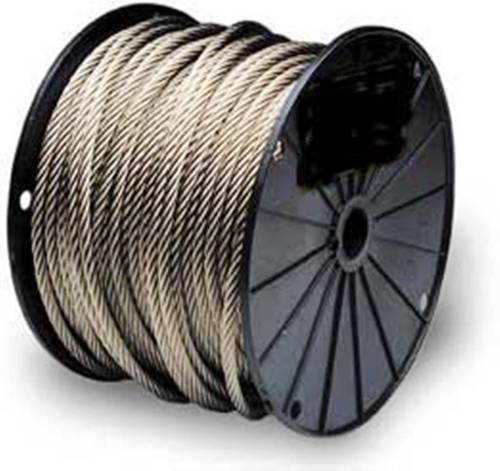Selecting the Right Wire Rope for Industrial Lifting
In industrial lifting For operations to be safe, effective, and long-lasting, wire rope selection is essential. The correct wire rope can significantly improve performance while reducing wear and hazards in a wide range of industries, including manufacturing, shipping, mining, and construction. We’ll go over important considerations for choosing the best wire rope for your industrial lifting requirements below.
1. Understanding the Composition of Wire Ropes
Usually composed of many steel wire strands wound around a core, wire rope is a complicated construction. Stainless steel, galvanised steel, and PVC-coated wire ropes are common materials, and each has unique advantages. For instance, stainless steel wire ropes are perfect for outdoor or marine applications because of their exceptional resistance to corrosion. Strong rust resistance is offered by galvanized wire ropes, while PVC-coated alternatives provide more durability and protection.Making the right material choice guarantees that your wire rope will endure the conditions and demands of the particular application.
2. Determining the Needs for Load
Knowing the weight of the load is essential when choosing a wire rope. The wire rope’s breaking strength, which is frequently included in its specifications, should be able to comfortably surpass the maximum load weight. Industrial lifting often necessitates a safety factor that is five times the operating load limit. This buffer guarantees that even under extreme force or prolonged use, the wire rope will continue to function well. You can increase durability and guarantee operational safety by selecting a wire rope with a breaking strength significantly higher than the weight.
3. Considering Strength vs. Flexibility
The strength and flexibility of wire ropes vary greatly. Think about using a more flexible wire rope with several strands if the application calls for bending, such on lifts or cranes. For example, a 6×19 construction provides the perfect mix of strength and flexibility, making it appropriate for a variety of lifting tasks. On the other hand, seek out wire ropes with fewer, larger strands, like a 6×37 construction, if you require greater tensile strength. Depending on your lifting needs, there may be a trade-off between their having a higher weight capacity and maybe being less flexible.
want to learn about the different strengths of various wire ropes
4,Evaluating the Core Type
A wire rope’s core offers extra support, preserving the rope’s resilience and form. Fibre core (FC), independent wire rope core (IWRC), and wire strand core (WSC) are the three primary types of cores. Each has particular uses:
Fibre Core (FC): Fibre core wire ropes are flexible and lightweight, making them appropriate for lighter applications but less robust when subjected to high loads.
– Independent Wire Rope Core (IWRC): IWRC is stronger and more durable, making it perfect for severe settings and heavy lifting.
The less popular Wire Strand Core (WSC) provides moderate strength and some flexibility.
By choosing the right core, you can make sure the wire rope can tolerate the temperature and pressure variations unique to your business.
5.Analysing the surroundings
The longevity and efficiency of wire ropes are significantly impacted by environmental factors. Performance can be impacted by variables like temperature, humidity, and contact with chemicals or abrasive materials. For instance, galvanised wire ropes are better suited for moderate outdoor exposure, but stainless steel wire ropes perform best in corrosive situations. Make sure the wire rope’s material can withstand high temperatures without losing strength or durability if the application calls for it.
6.Analysing the Needs for Length and Diameter
The wire rope’s lifting efficiency is directly influenced by its diameter and length. Generally speaking, a thicker wire rope is stronger but may be less flexible. The diameter of pulleys, blocks, and sheaves should be selected with the load needs and space constraints in mind. Additionally, don’t use more rope than is required because too much rope can provide slack, which could be dangerous and impair control.
7.Taking Rotation Resistance into Account
Rotation resistance is crucial in several lifting activities, particularly vertical lifting, to keep the load from twisting. Low-rotation or non-rotating wire ropes are specifically made for applications like lifts and cranes where spin control is required. These ropes provide stability and reduce the possibility of twisting loads, which can harm the wire rope as well as the load.
Looking to buy a wire rope that accounts for rotation resistance.
8.Regular Maintenance and Inspection
To guarantee ongoing safety and functionality, routine inspection and maintenance are necessary even after choosing the appropriate wire rope. Indicators of deterioration can be found by regularly inspecting for wear, corrosion, kinks, and broken wires. For ropes used in high-friction applications in particular, proper lubrication is essential to prolonging the lifespan.
In conclusion
A thorough evaluation of various aspects, including material, weight requirements, flexibility, core type, environmental conditions, and rotation resistance, is necessary when selecting the best wire rope for industrial hoisting. You can guarantee the longevity and safety of your lifting equipment in addition to its efficiency by choosing a wire rope that fits the particular requirements of your application. To sustain performance over time, always adhere to manufacturer instructions and think about doing routine inspections.
To sum up, choosing the right wire rope is crucial for safe and efficient lifting in commercial environments. Understanding these important factors will help you make an informed decision, maximising your lifting operations and safeguarding your investment over time. Specifications may vary according on the application.

